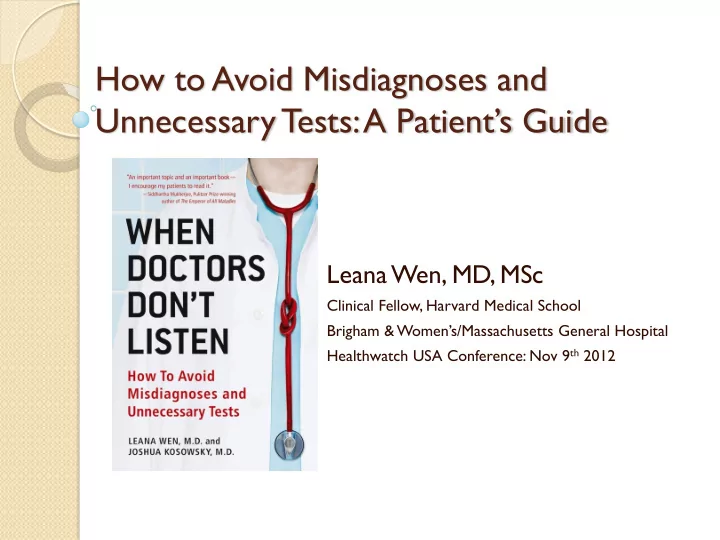

How to Avoid Misdiagnoses and Unnecessary T ests: A Patient’s Guide Leana Wen, MD, MSc Clinical Fellow, Harvard Medical School Brigham & Women’s/Massachusetts General Hospital Healthwatch USA Conference: Nov 9 th 2012
The story of Jerry “chest pain” “chest pain pathway” Overnight stay
The problem Unnecessary tests & side effects The doctor isn’t listening. The patient isn’t involved with his/her healthcare. Doctors and patients are disconnected, frustrated, with more testing and treatment, but far fewer answers.
Pressures and consequences Lots of patients, little time Use technology instead of talking to patients Medical training “Cookbook medicine”, not personalized medicine Passive acceptance by patients
Misdiagnosis 100,000 deaths from medical errors per year Most medical errors are errors in diagnosis. 80%+ of diagnoses are made based on history. But doctors are listening less and less….
What does all of this tell us? Doctors need to be better Healthcare system needs to be reformed But we cannot wait! Patients need to: ◦ Ensure doctors are listening ◦ Challenge doctors ◦ Be equal partners ◦ Make sure to get the right diagnosis
#1. Establish an equal partnership with your doctor Find a good doctor, if you can Make sure your doctor knows that you expect an equal partnership Partner in your decision-making Ask to share in the thought process
#2: Focus on your diagnosis Why is diagnosis so important? ◦ Before you treat it, know what it is ◦ Know what you have so you know what to expect, what to watch for, what to do about it Never leave the doctor without knowing your diagnosis Assure your doctor, it’s OK if not 100% sure
#3: Make sure your doctor is listening Not listening leads to grave errors Tell a good story ◦ Begin at the beginning ◦ Provide context ◦ Use your own voice Write down key details Rehearse
#4. Understand every test ordered Every test should be done for a specific reason Little use for “screening” test Every test has potential harms Ask: ◦ What is it looking for? ◦ How is the test going to change management? ◦ Is it necessary? ◦ What are the harms? Alternatives?
#5. Ask all questions before you leave Come prepared with questions ◦ Pen/paper ◦ Trusted friend/family member Some questions: ◦ What is my diagnosis? ◦ What can I expect? ◦ What can I do to get better? ◦ What are the warning signs? If something doesn’t seem right, ask about it now
Can you become an empowered patient? Absolutely! Your body and your health at stake. NOW is the time to get the healthcare you deserve. 8 Pillars to Better Diagnosis 50+ “Prescriptions” 21 Exercises 4 Worksheets
Conclusions Lots of pressures leading to bad healthcare system You can make a difference in your care, today ◦ Establish an equal partnership with your doctor ◦ Focus on your diagnosis ◦ Make sure your doctor is listening ◦ Understand every test ordered ◦ Ask all questions before you leave Final follow-up
Leana Wen, MD, MSc Clinical Fellow, Harvard Medical School Brigham & Women’s/Massachusetts General Hospital www.DrLeanaWen.com www.whendoctorsdontlisten.com @DrLeanaWen Wen.Leana@gmail.com
Recommend
More recommend